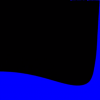Conversion between spaces of different dimensions (for example from 3D to 2D as in when displaying 3D graphics on a 2D screen) is called "projection"
There are many ways to project, one of them is the standard perspective projection, which means objects far away appear smaller, and you have a single "vanishing point".
This is where the "frustum" comes into play. The word "frustum" doesn't really have to do with projection though, it's just a name for a solid shape cut with 2 planes. (In our case, a pyramid)
You can also use an orthogonal projection, then objects farther away is the same size. This isn't strictly correct (more wrong the closer the objects are) but it can still give a 3D feel, specially for a single object, and is commonly used in technical drawings.
It can be useful in games too, I actually downloaded one today called "Monument Valley" for iOS that uses it to great effect.
Also all "isometric" games use this.
Another way to do the illusion of 3D is the "two point perspective" and was popular in art from a couple of hundred years ago.
You could also imagine a warped frustum which does not have linear "walls", that is, more like a trumpet then a pyramid.
I saw this used in a wooden carved piece this weekend, to give the illusion of more 3d then actually was there. (It did protrude from the wall, but not as much as it looked like)






